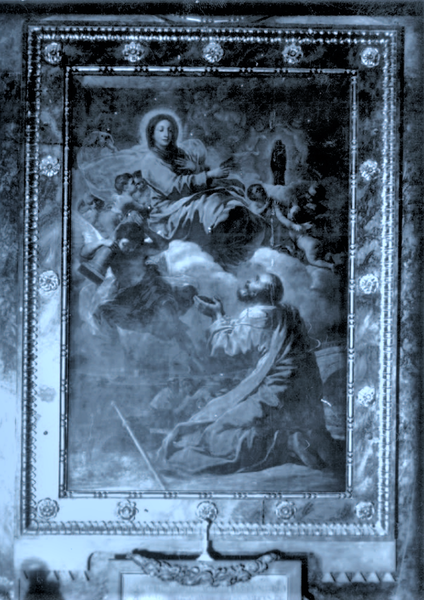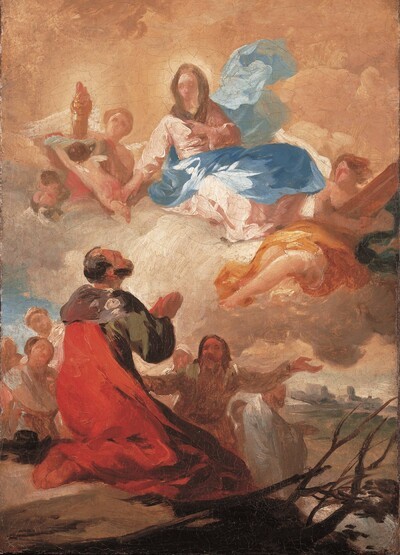- Cronología
- 1783
- Ubicación
- Lost work
- Dimensiones
- 220 x 160 cm
- Técnica y soporte
- Oil on canvas
- Reconocimiento de la autoría de Goya
- Documented work
- Titular
- Ailsa Mellon Bruce Collection
- Ficha: realización/revisión
- 14 Jan 2010 / 13 Jun 2023
- Inventario
- -
- Otros títulos:
-
Apparition of the Virgin of the Pillar to the Apostle Saint James (Aparición de la Virgen del Pilar al apóstol Santiago)
In 1782 Goya received the commission to paint the altarpiece next to the main altar (Evangelical side) of the parish church of San Pedro in Urrea de Gaén in Teruel, the same year in which the building was finished. The project is related to the renovation of the churches belonging to the Hijarano estate, sponsored by the 10th Duke Pedro Pablo Alcántara de Silva Fernández de Híjar.
In a letter from Goya to Martín Zapater dated 26 April 1783 the artist mentions payment of 3,000 reales received from the Duke of Híjar for an unspecified work. Sánchez Cantón believes that this was the piece in question.
The canvas was destroyed in the summer of 1936 at the start of the Spanish Civil War.
This was not the only work carried out for the Church of Urrea de Gaén, since Ramón Bayeu also took part in this project, painting the Saint Peter, Martyr of Verona (San Pedro Mártir de Verona) for the main altarpiece, as did José del Castillo, author of the Saint Augustine (San Agustín) for the altarpiece on the Epistle side.
This work by Goya is known only from photographs taken by Juan Mora Insa. The subject was not new to Goya, as he had depicted it in his first known work, the doors of the reliquary of the Church of Fuendetodos, Zaragoza, as well as on various occasions for small devotional paintings commissioned by private clients.
The Virgin Mary appears on clouds, accompanied by her devoted host of angels, who carry her image and the column. It has a gentler aspect than the surviving sketch, which was painted in a much more spontaneous manner. Some figures have been eliminated from the final painting, and secondary figures are also given less importance. In general, this painting features a more simple composition than that used by Goya on previous occasions. Although it maintains the diagonal line of the sketch, it is also more static and monumental.
Saint James still shows the influence of Antonio González Velázquez, and is reminiscent of the image of the apostle painted on the doors of the reliquary. Following the discovery of the Italian Notebook, this figure has also been compared with the figure of Abraham which appears in a sketch in the notebook. In that drawing, God appears to Abraham to order him to construct an altar. When Mary appears to Saint James she orders him to build a chapel to hold his image, thus completing the parallelism between the two works.
A preparatory study and a sketchfor this work have survived.
-
Vie et ouvre de Francisco de GoyaParísOffice du livre1970pp. 77, 93, cat. 192
-
BarcelonaPolígrafa1970vol. I, p. 279, cat. 281 y fig. 400 (il.
-
L’opera pittorica completa di GoyaMilanRizzoli1974p. 98, cat. 144
-
Goya y Aragón. Familia, amistades y encargos artísticoscol. Col. Mariano de Pano y RuataZaragozaCaja de Ahorros de la Inmaculada de Aragón1995pp. 142-145 y p. 144 (il.)
-
Goya, Ramón Bayeu y José del Castillo en los retablos de las iglesias parroquiales de la Puebla de Híjar, Vinaceite y Urrea de GaénArchivo Español de Arte2002pp. 180-182

